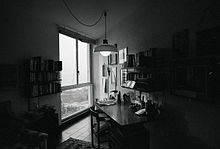Franco Maria Ricci

Franco Maria Ricci (2 December 1937 – 10 September 2020) was an Italian art publisher and magazine editor. Amongst his publications is FMR, a Milan-based bi-monthly art magazine published in Italian, English, German, French, and Spanish for over 27 years. Ricci is known for having created limited editions honoring particular independent artists, which are characterized by their tinted handmade paper, and black silk-bound hardcovers with silver or gold lettering stamping. He sold his publishing house, Ricci Editore, to Marilena Ferrari in 2007 only to regain control in 2015.[1]
FMR magazine
[edit]The first issue of FMR was published in 1982.[2] The title FMR is made of the initials of the publisher's name and also, when pronounced in French, sounds like éphémère, a word with rich connotations that translates as "fleeting" or "transitory". It contained noteworthy iconological and art historical studies, illustrated with large photographs and drawings reproduced on a black background. Among FMR's high-profile admirers were Federico Fellini, who called it the "black pearl",[3] and Jacqueline Kennedy, who declared that it was "the most beautiful magazine in the world".[4] In December 2002, twenty years after the release of the first issue, Ricci sold the magazine to Marilena Ferrari's company Art'é to focus on his old ambition to build the largest maze in the world, "Labirinto della Masone", in Fontanellato.[5] In 2003 art critic and curator Flaminio Gualdoni replaced Ricci as editor of the magazine. In 2007 FMR was augmented by FMR White, a sister publication devoted to contemporary art. Over the years the two publications featured many notable contributors, including Alberto Arbasino, Peter Bloch, Jorge Luis Borges, Italo Calvino, Umberto Eco, Giovanni Mariotti, Octavio Paz, Nicola Spinosa, and Giovanni Testori. Both FMR and FMR White ceased publication in 2009. In 2015, after completing the seven-hectares wide maze also featuring an art museum and a library, Ricci bought back the copyrights of FMR with the potential intent to resume publication.
Other publications
[edit]Ricci is known for having published the original edition of the Codex Seraphinianus and some of Guido Crepax's books.
References
[edit]- ^ "FMR-Art'e' -- History". Archived from the original on 2015-01-20. Retrieved 2015-01-20.
- ^ "FMR FINE ART PUBLISHING HOUSE". Archived from the original on January 20, 2015.
- ^ "Become an FT subscriber to read | Financial Times". www.ft.com.
- ^ "Designculture • FMR".
- ^ "Franco Maria Ricci — Stories Apartamento Magazine". 11 May 2018.
External links
[edit] Media related to Franco Maria Ricci at Wikimedia Commons
Media related to Franco Maria Ricci at Wikimedia Commons- Official website
- Ricci editore
- Designboom portrait
- Designboom interview
- Month Magazine interview
